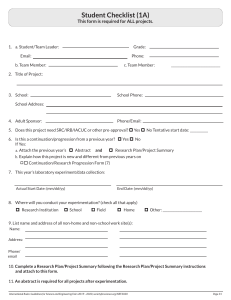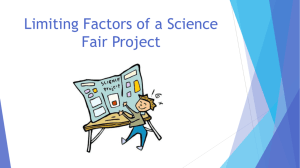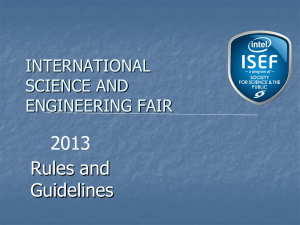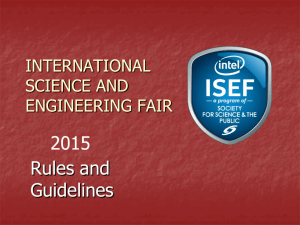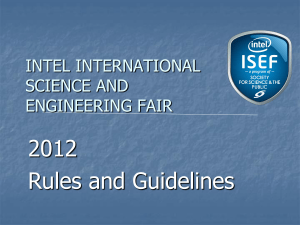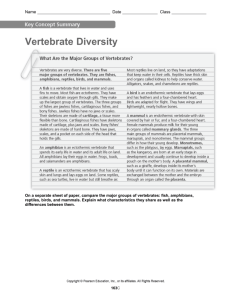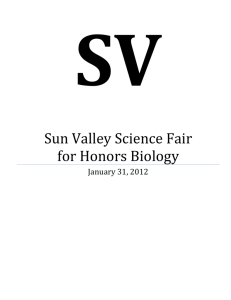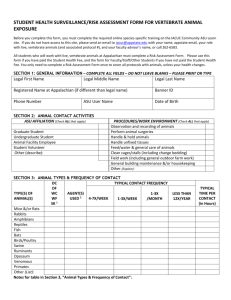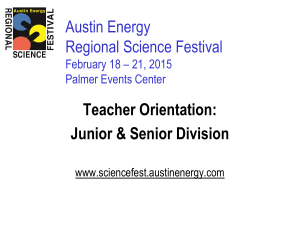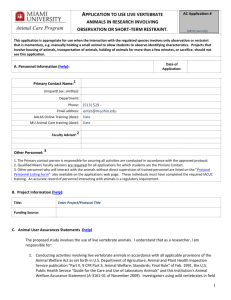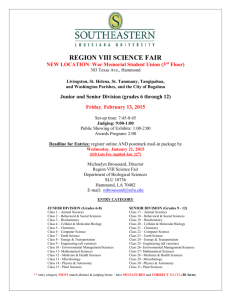2015 Intel ISEF-affiliated Science Fair Forms
advertisement
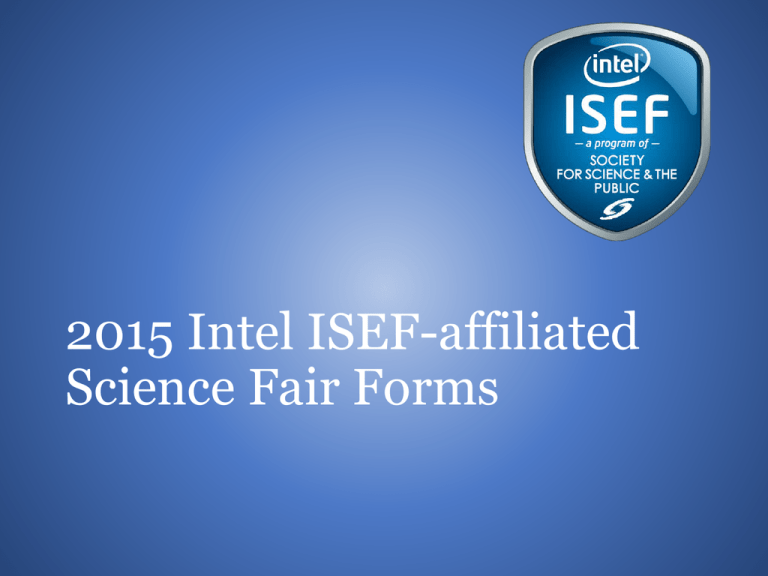
2015 Intel ISEF-affiliated Science Fair Forms Forms??? • Required by the Society for Science and the Public and Intel ISEF for all projects competing in any affiliated fairs (i.e. FWRSEF, EMTSEF) • Ensure safety and ethics of experimental practices • 2014-2015 forms can be found on the SSP website: https://student.societyforscience.org/forms • If you need more details into any of the rules, use the 2015 Intel ISEF handbook: member.societyforscience.org/document.doc?id=398 General Overview • ALL PROJECTS require Forms 1, 1A, 1B, and a Research Plan • Most TAMS projects fill out Forms 1C, 2, and 3 • Specific forms are required for certain projects • For a project dealing with: • • • • • Human Subjects: Form 4 Vertebrate Animals: Form 5B Biological Agents: Form 6A Tissues: Forms 6A and 6B Continued Projects: Form 7 Form 1: Checklist for Adult Sponsor • Your adult sponsor is the PROFESSOR you are working with, not TAMS admin! • Check all boxes that apply to your project. This indicates all necessary forms for your project. • Forms Wizard (lets you know what forms to use): https://apps2.societyforscience.org/wizard/index.asp • When deciding on a title, it is best to not change it once forms have been filled out Form 1A: Student Checklist • A complete address is required for school as well as research locations (i.e. the TAMS school address is 1167 Union Circle, Suite 202, Denton, TX 76203) • Be sure that start and end dates do not exceed a 12-month period! End date is recommended to be set at late February Form 1B: Approval • Make sure you and your parent sign this form before your start date! • Section 2 a/b required only if working with humans, vertebrates, and/or potentially hazardous biological agents Research Plan • Follow instructions for the research plan exactly; be sure to use present or future tense, as forms are approved before experimentation • Do not forget data analysis! • If your project involves human subjects, vertebrate animals, potentially hazardous biological agents, and/or hazardous chemicals/devices, be sure to include safety information (can be copied over from respective forms). You must include this information about risk and safety. Form 1C: Regulated Research Institution/Industrial Setting • Required if you conducted your research in a research lab (most of TAMS) • Supervising Adult is the one working alongside you in the project: typically graduate student • The supervising adult CAN be your professor if your professor is the one working DIRECTLY with you (i.e. watching/ directly supervising as you experiment) Form 2: Qualified Scientist • Required only if you worked with human subjects, vertebrate animals, potentially hazardous biological agents, and/or DEA-controlled substances • Qualified Scientist is your professor • Designated Supervisor works alongside (probably graduate student) • Be sure that the experience/training section is completed for both! Form 3: Risk Assessment • Required if using hazardous chemicals/devices and microorganisms exempt from preapproval • i.e. DEA-controlled substances, prescription drugs, alcohol/tobacco, hazardous chemicals/devices/activities, radiation • All chemicals are considered hazardous! • Be sure to list source, quantities, and concentrations of all chemicals!! Form 3 (cont’d.) • For chemicals, use MSDS to assess risk, safety, and disposal procedures • Attach all relevant MSDS forms! Form 3 (cont’d.) • There are some studies that are exempt from prior SRC review that require Form 3! • Studies involving protists, archae and similar microorganisms • Research using manure for composting, fuel production, or other non-culturing experiments • Studies using commercially available color change coliform water test kits • Studies involving decomposition of vertebrate organisms (forensic studies) Form 4: Human Participants • Projects involving intervention or interaction with human participants AND/OR collection of identifiable private information require completion of Form 4 • You do not need Form 4 if: • Product Testing with no health hazards or personal data collected • Behavioral Testing in unrestricted public settings • Studies using certified de-identified/anonymous data Form 4 (cont’d): Human Consent Form • Projects must be reviewed and approved BEFORE experimentation • Informed consent form must be completed by participants • Participants 18 or older give informed consent • Participants under 18 must give assent and their parents may be required to give permission Form 5B: Vertebrate Animals • What is a vertebrate animal? According to ISEF: • Live, nonhuman vertebrate mammalian embryos or fetuses • Bird and reptile eggs within 3 days of hatching • All other nonhuman vertebrates (including fish) at hatching or birth • Zebrafish embryos 7+ days (168+ hours) post fertilization • If there are no interaction with animals, manipulation of the environment, or all federal wildlife regulations are followed, then this form is not required Form 5B (cont’d.) • SOME STUDIES ARE PROHIBITED! • Induced toxicity studies involving known toxic substances that could impair health or destroy life • Behavioral experiments with • Conditioning using aversive stimuli • Mother/infant separation • Induced/learned helplessness • Studies of pain • Predator/vertebrate prey experiments Form 5B (cont’d.) • Research lab/project must be approved by IACUC: attach letter from IACUC with forms • Professor completes the form • Local SRC should review project before experimentation • Experimentation must follow ISEF guidelines Form 6A: Potentially Biologically Hazardous Agents • Required for both microorganisms/rDNA/blood products AND tissues. • Have either your graduate student OR professor fill it out. MUST be signed before experimentation. Form 6A (cont’d.) • Studies must have prior approval by SRC/IACUC/IBC • Most studies are prohibited in a home environment • Studies intended to genetically engineer bacteria with multiple antibiotic resistance are prohibited • Lab studies utilizing MRSA, VRE and KPC must be conducted in a Regulated Research Institution under documented IBC review and approval YOU ARE EXEMPT FOR STUDIES: • Studies using baker’s and brewer’s yeast (except rDNA studies) • Studies using Lactobacillus, B. thurgensis, nitrogen-fixing bacteria, oileating bacteria, and algae-eating bacteria in natural environment. Not exempt if cultured in a petri dish environment • Studies of mold growth on food items if experiment terminated at first sign of mold • FORM 3 is still required Form 6B: Human and Vertebrate Animal Tissues • If you are dealing with tissues, you must fill out form 6A AND 6B. • Fixed tissue does NOT need form 6B. • Need form only for: • • • • • Fresh/frozen tissue Primary cell cultures Human and other primate established cell lines and tissue cultures Blood and blood products Body fluids • Exempt Studies: • Plant tissue • Plant and non-primate established cell lines and tissue culture collections (e.g., obtained from the American Type Culture Collection). The source and/or catalog number of the cultures must be identifi ed in the Research Plan. • Fresh or frozen meat, meat by-products, pasteurized milk or eggs obtained from food stores, restaurants, or packing houses • Hair • Teeth that have been sterilized to kill any blood- borne pathogen that may be present • Fossilized tissue or archeological specimens. • Prepared fixed tissue Form 6B (cont’d.) • If animal is euthanized solely for student project – vertebrate animal study which requires IACUC approval • If animal is euthanized for a purpose other than student project – tissue study • Classification as BSL 1 or 2 based on source of tissue and possibility of containing infectious agents • All studies with human or wild animal blood are BSL 2. Studies with domestic animal blood are BSL 1. • Studies with human body fluids which can be associated with a person must have IRB approval Form 7 (Continuation) • Continuing your project is great—it shows consistency; however, your project must be significantly different from last year’s, and only data collected within the second year should be used as the bulk of your results. • Attach last year’s abstract AND research plan and the year before that’s abstract only. Abstract • Hard word limit is set at 250 words. • Form: http://member.societyforscience.org/document.doc?id=24 • The purpose of your abstract is to give the reader an overall idea of how you conducted your project/ your findings/application of these results. TIPS: • First sentence can begin with problem/issue to solve. Can have brief hypothesis. • LIFE SCI: It is best to go over your procedures/methods briefly. The main focus of your abstract should be your results, conclusion, future apps. If you have space, you can be a little more specific about your results. • ENGINEERING: It is ok to talk more about your methods and procedures, focus on future apps as well. • Always have good grammar/spelling, can look up abstracts in your field for samples Good luck with forms!

